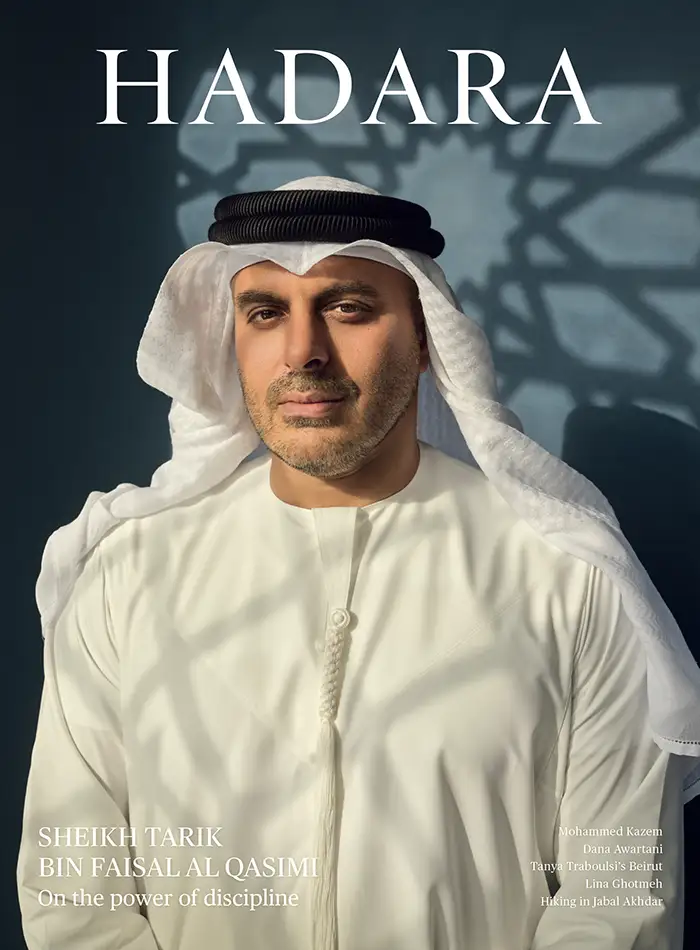Material Man
Light, time, and materials define Dutch architect Anne Holtrop’s work along Bahrain’s Pearling Path.
by Charles Shafaieh
Cultured pearls make up 99% of the world’s pearl market, for good reason: experts believe only 1 in 10,000 wild oysters produces a pearl, very few of which are fit for jewellery. But natural pearls are the only permitted varietal in Bahrain, which has been celebrated for millennia as the source of some of the world’s finest specimens.
At the new Siyadi Pearl Museum in Muharraq, designed by Dutch architect Anne Holtrop, visitors can view archival and contemporary examples of these rare gems dating as far back as 2000 BCE, on loan from the national museum, Cartier, and local private collections. Part of a UNESCO World Heritage Site, the museum is an important stop along the Pearling Path, a 3.5-kilometre route that opened in February which honours the island’s once-vital pearl industry. Featuring repurposed heritage buildings and striking new structures by Valerio Olgiati, Christian Kerez, and other international architects, the urban trail connects the shore at Bu Mahir to the heart of Muharraq via a labyrinth of narrow alleyways and shaded squares.
The museum is housed in the former majlis of the Siyadis, one of Bahrain’s most prominent pearl-trading families. The Siyadi complex, which also includes a family residence and a mosque, dates in part to 1850. Architectural flourishes such as stained-glass windows and exterior etchings—sensitively restored during the eight-year project—attest to the family’s wealth.
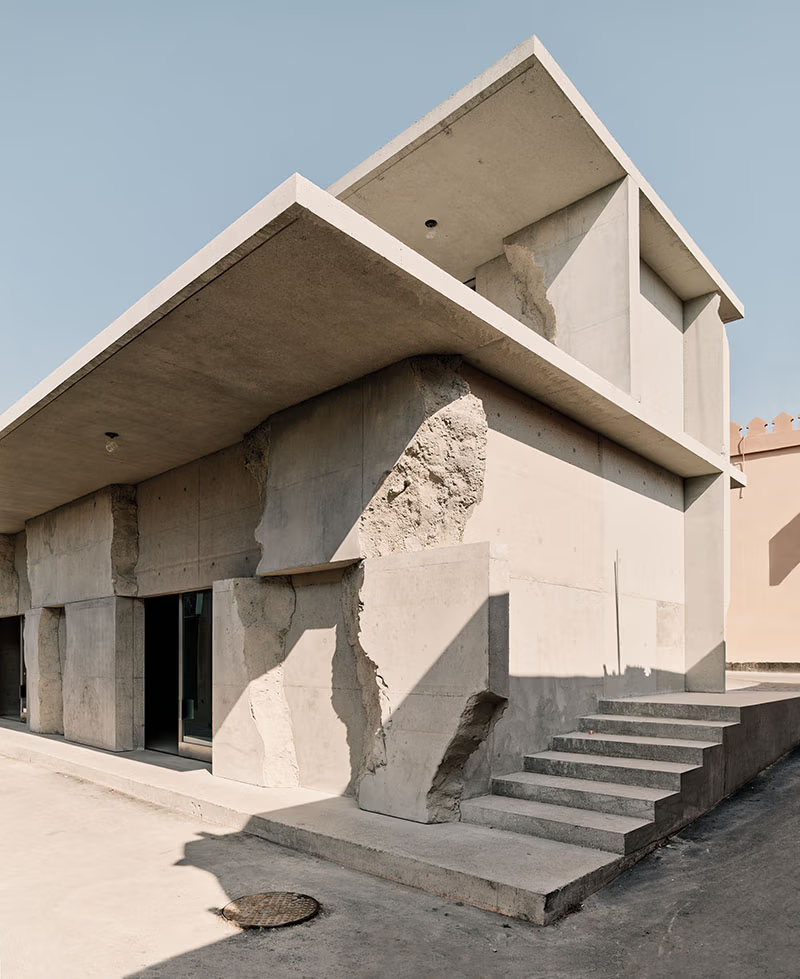
At Suq Al Qaysariyyah, opening image and above, new shop entrances are flanked by massive, raw concrete slabs with rough casted borders. It employs a building method for which Studio Anne Holtrop has become known: sand casting. The Suq has been an intrinsic element of Muharraq’s urban fabric for 200 years. Close to the shore, the market was an integral part of the historic pearl industry. The contemporary shops, designed by Studio Anne Holtrop, opened in 2021. Both photos by Iwan Baan, courtesy of Studio Anne Holtrop
Holtrop is leading the adaptation of other buildings along the path, too. Nearby Murad House, a classic, coral-stone structure and the former home of another merchant family, has a new addition with a courtyard garden designed by Madison Cox. It is scheduled to open as a boutique hotel later this year. Suq Al Qaysariyyah, the city’s oldest market and once a port that stored wood for the construction of pearling fleets, has been dramatically redeveloped in a fusion of modern and traditional architecture that puts a row of new storefronts facing existing shops.
Visitors to the museum galleries will immediately be aware of the natural light that strikes the jewels from the side. This angle references the traditional method by which Bahrainis examined pearls, at desks beside windows until the sun receded in mid-afternoon.
Light is a primary component of every Holtrop project. Despite growing up and beginning his career in the birthplace of Rembrandt and Vermeer, he only became hypersensitive to it when he moved to Bahrain in 2014. “The conditions of light and shadow define and articulate space,” he says from his studio in Muharraq, located in one of the warehouses on the Pearling Path historically used for trading and which he also renovated. “Here we have blazing light. On an average day, it is six times stronger than on the sunniest day in Europe. Everything you view under it becomes extremely sculptural.” This is as true of the jewellery on display as facets of the building itself, among them the monumental entrance door that is made primarily of kiln-formed glass.
Foregrounding light also calls attention to time, another major consideration in the museum’s design. Sizable patches of unfinished plasterwork inside and out suggest simultaneously that construction is ongoing and that the building is a preserved ruin. Additionally, the primary exhibition spaces, some of which reach eight meters high, are lined with silver leaf that has already begun to develop a patina thanks to an unusual process. After the silver was applied, Holtrop’s team boiled pots of black salt from the nearby market, intensely humidifying the rooms and releasing the heavy impurities in the mineral. The silver’s interaction with this atmosphere transformed its appearance to a light gold.
“The conditions of light and shadow define and articulate space. Here we have blazing light. On an average day, it is six times stronger than on the sunniest day in Europe. Everything you view under it becomes extremely sculptural.”
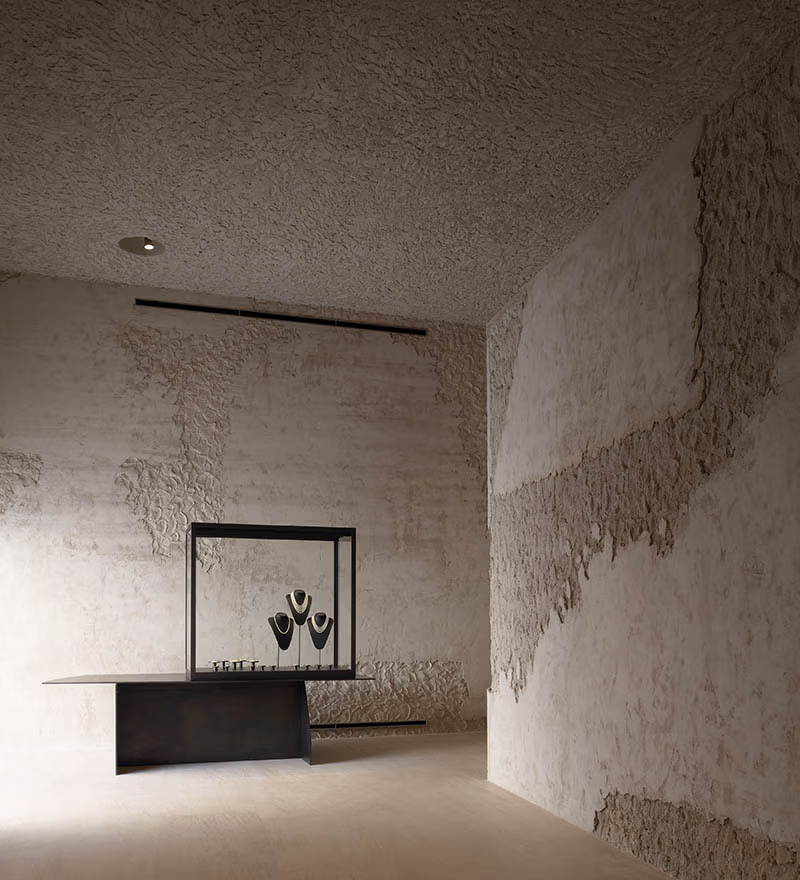
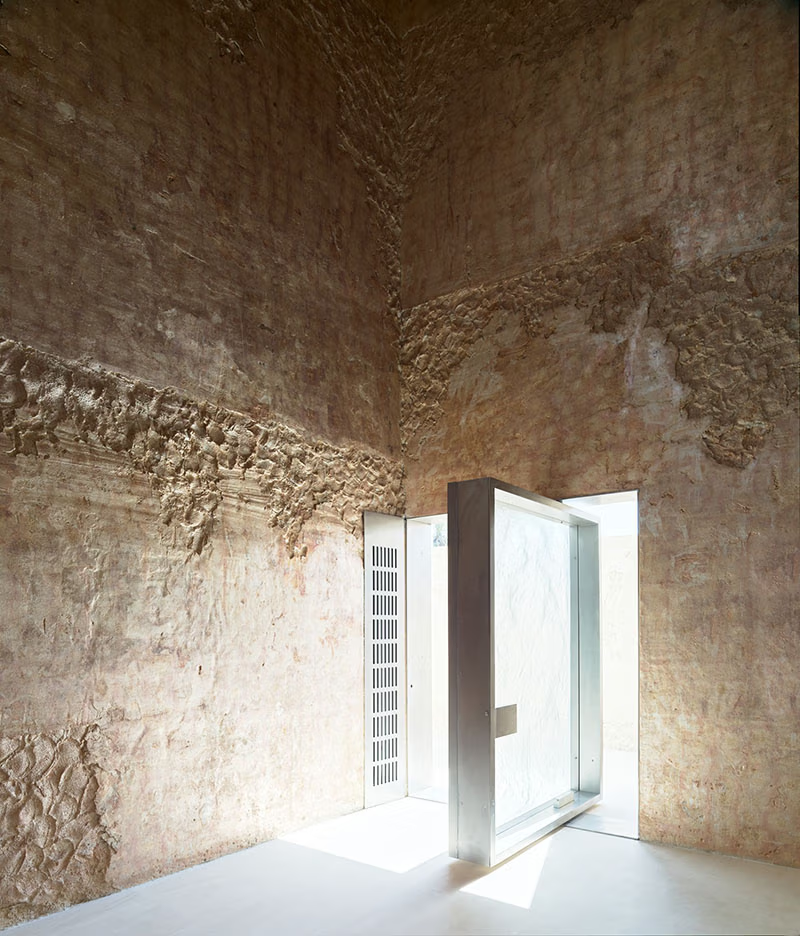
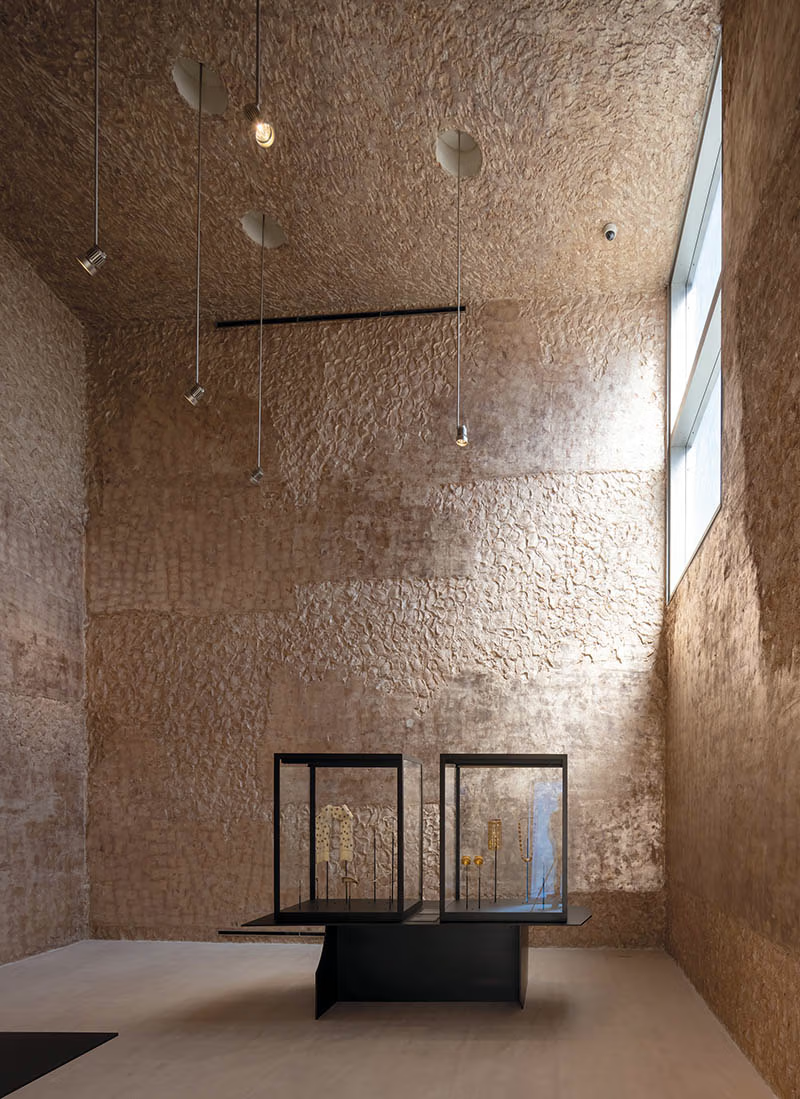
Siyadi Pearl Museum The museum is housed in the former majlis of a prominent pearl-trading family. Sizable patches of unfinished plasterwork inside and out suggest simultaneously that construction is ongoing and that the building is a preserved ruin. The primary exhibition spaces, some of which reach eight meters high, are lined with silver leaf that has already begun to develop a patina. The monumental entrance door, top right, is made primarily of kiln-formed glass. Courtesy Studio Anne Holtrop (2); Bottom image: iwan baan
“It was very experimental,” he says. “Such a fast thing changed the whole condition of the space. Architecture is a slow profession, and I found it beautiful that, overnight, its real appearance came forward. And it is ongoing—we didn’t seal it.” Next, the silver will turn a shade of orange-beige. Eventually, Holtrop believes, it will appear completely black.
For an architect obsessed with materiality, Bahrain is ideal. Holtrop’s relationship with the country began a decade ago, when he won the commission to design its national pavilion at the Milan Expo and visited for the first time. This was also when he met his wife, Noura Al Sayeh Holtrop, a Palestinian architect and curator working for the Bahrain Authority for Culture and Antiquities who also played a major role in the Pearling Path project. When the couple deliberated where to live, Bahrain’s environment had a sizeable pull on the Dutchman. “I am really attracted by arid countries because there is no vegetation, and all the mineral material is just lying there. You can already see the colour and consistency of the compositions,” he says. “It’s the biggest building-material shop you can imagine.”
Holtrop celebrates this natural landscape through a building method for which he has become known: sand casting. The process involves making moulds on the ground at a building site, which reduces the need for extraneous resources and also creates a physical record of a unique time and place. The results—be they in glass, aluminium, or concrete—are inextricably linked to their surroundings. In some instances, Holtrop designs huge swathes of a building using this method, including the Suq where the new shop entrances are flanked by massive, raw concrete slabs with rough casted borders. For the forthcoming Misk Art Institute in Riyadh, Holtrop’s biggest project to date at around 25,000 square metres, cast glass imprinted with local limestone will form the entire facade.
“I consider all of my work to be site specific, which is very much related to materiality—how materials are sourced, the techniques developed from them, the craftsmanship that has defined their shaping and therefore the shaping of that architecture.”
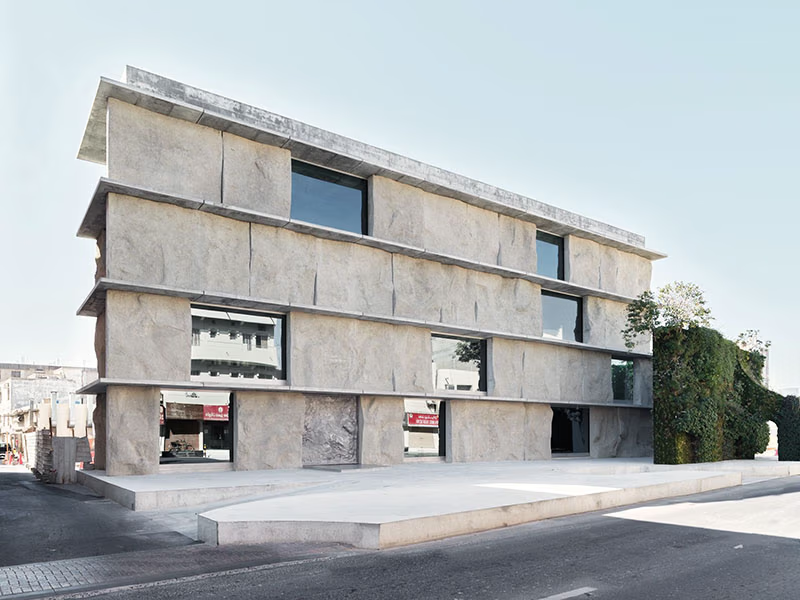
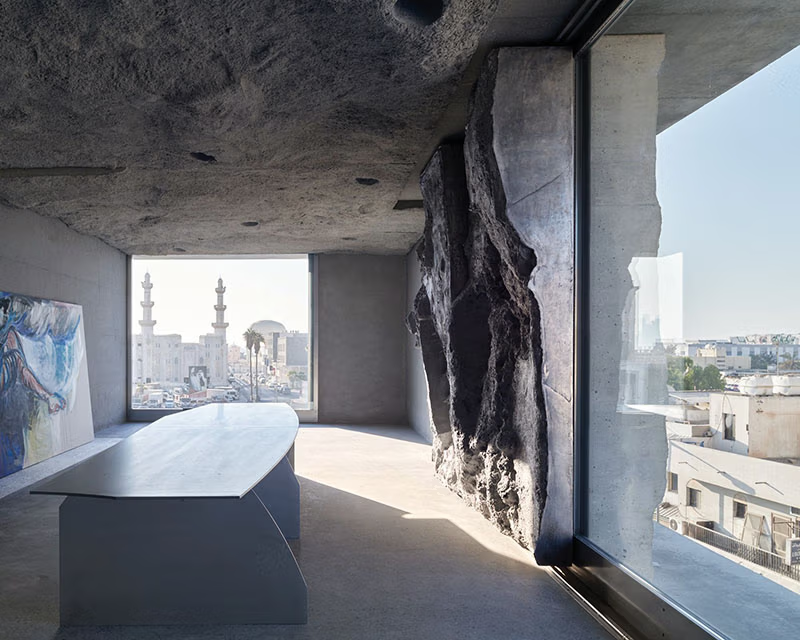
35 Green Corner Building Close to the Pearling Path, the façade of this building is made of sand-casted structural wall elements that were cast on the ground next to the building. The space serves as art collection storage for the Shaikh Ebrahim Center. Courtesy of Studio Anne Holtrop
The intense climatic conditions pose challenges, too, particularly for construction. The water surrounding Bahrain has extremely high salinity, and the summers are intensely humid. For traditional architecture such as the Siyadi complex, the Suq, and the Murad House, coral stone was commonly extracted from nearby reefs and used as a base material, in combination with lime plaster. But the salt trapped within the coral stone absorbs water and then expands, causing cracks. A solution could have been conjured in a laboratory divorced from Bahrain’s traditions. Holtrop, however, relishes learning from and adapting historical methods. After studying the restoration and conservation work that had been accomplished during earlier stages of the project, he introduced crushed oyster shells into the plaster. Their presence increases the coral stone’s porosity and makes the buildings breathable.
“I consider all of my work to be site specific, which is very much related to materiality—how materials are sourced, the techniques developed from them, the craftsmanship that has defined their shaping and therefore the shaping of that architecture,” he says. In the case of salinity, he considered it a productive opportunity to turn what most architects would consider an enemy into a friend.
Problem solving and ingenuity at such a granular level demand that Holtrop and his team be immersed in all aspects of a project. His clients are often surprised by their daily presence at building sites. But for him, this is fundamental. “Architecture is not on paper alone. It is also how we interact with the site itself,” he asserts. “I always had the wish to become an artist. I need things in my hands, in my fingers. I need to feel them. Then I understand what we can do.”




